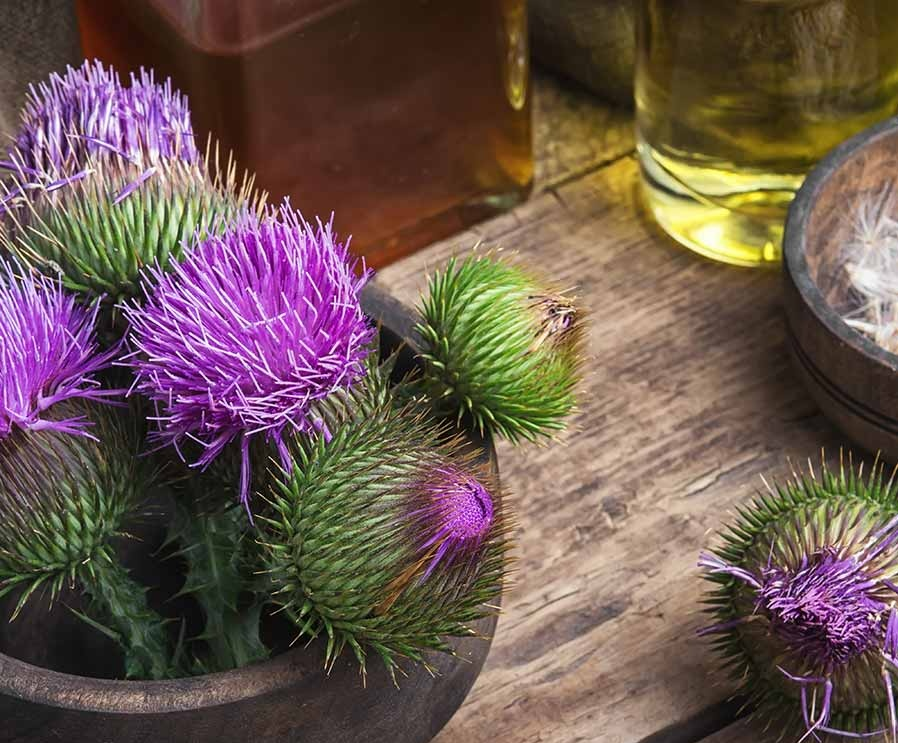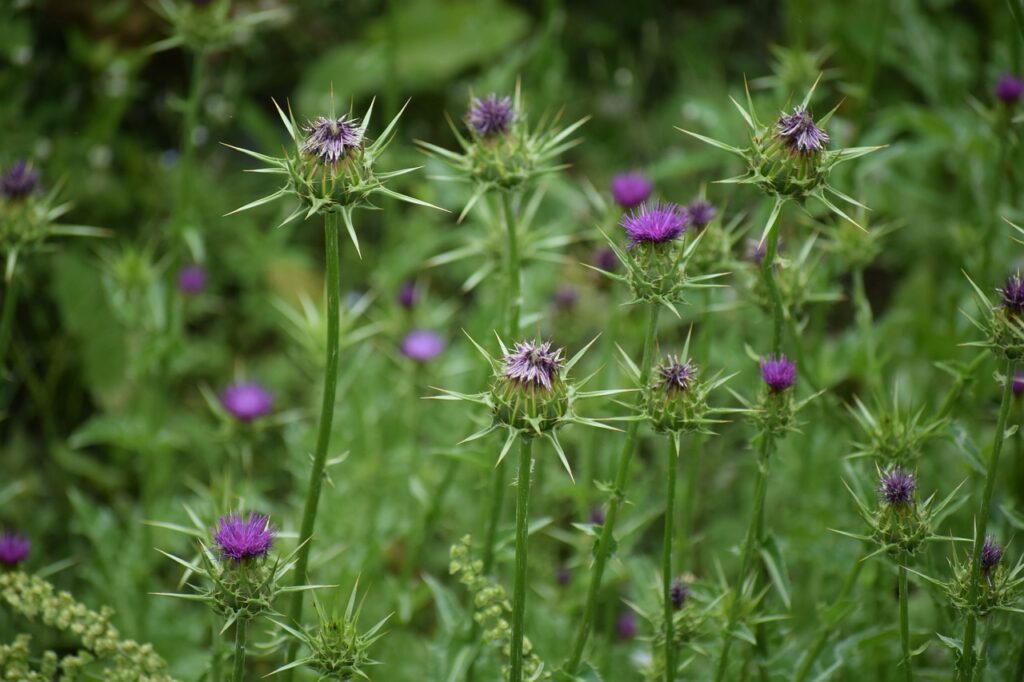This Content Is Only For Subscribers
Introduction
In the vast world of herbal remedies, few plants have garnered as much attention and research as Milk Thistle (Silybum marianum). This unassuming plant, with its distinctive purple flowers and milky white veins on its leaves, has been used for centuries in traditional medicine for its remarkable healing properties.

From ancient remedies to modern research, Milk Thistle has proven to be a valuable ally in promoting liver health, managing various conditions, and supporting overall well-being. In this article, we’ll embark on a comprehensive exploration of Milk Thistle, delving into its botanical characteristics, historical significance, key components, health benefits, usage, and precautions.
Table of Contents
Milk Thistle: Botanical Description and Historical Aspects
Appearance and Growth:
Milk Thistle is a member of the Asteraceae family, a group of plants that includes daisies, sunflowers, and artichokes. It’s an annual or biennial plant, typically growing to a height of 4-10 feet. It’s identifiable by its:

- Leaves: Large, spiny, and glossy with distinctive white veins that give the plant its common name “Milk” Thistle. The leaves can be quite prickly, giving it a thistle-like appearance.
- Flowers: Showy, purple-to-pink, thistle-like flower heads that bloom in summer.
- Seeds: The seeds are small, hard, and dark brown, often with a silvery sheen. They are the primary source of the beneficial compounds.
- Growth: Thrives in sunny, dry conditions, often found in fields, along roadsides, and in disturbed areas. It is native to the Mediterranean region but is now found worldwide, and can be commonly found across Europe and North America.
Historical Significance: Silybum marianum
Milk Thistle’s history of use dates back over two thousand years, with mentions in ancient Greek and Roman texts. Its use is deeply rooted in European and Mediterranean traditional medicine:
- Ancient Greece & Rome: Pliny the Elder, a Roman naturalist, noted Milk Thistle’s benefits as a liver tonic in the first century AD.
- Medieval Europe: Herbalists in the Middle Ages used Milk Thistle for treating liver disorders, jaundice, and gall bladder problems.
- Traditional European Medicine: The herb has been a staple in European herbal medicine for centuries, used for liver ailments and as a general tonic.
- Modern Re-discovery: In the late 20th century, modern science began to investigate the traditional claims of Milk Thistle, leading to a resurgence in its popularity and a deeper understanding of its active compounds.
- Folklore: Many old folklore stories associate the white veins on the leaves with the Virgin Mary’s milk, hence it got the name Milk Thistle.
Key Components of Milk Thistle
The remarkable properties of Milk Thistle can be attributed to a complex mixture of bioactive compounds, primarily:
- Silymarin: A group of flavonolignans that is the main active component of It . It’s not a single compound but a mixture of several, including silybin (also known as silibinin), silydianin, and silychristin.
- Silybin: The most active and well-studied component of silymarin, largely responsible for Milk Thistle’s hepatoprotective and antioxidant effects.
- Other Flavonoids: Including taxifolin, quercetin, and apigenin which have shown beneficial antioxidant and anti-inflammatory properties.
- Fatty Acids: Linoleic acid, oleic acid, and palmitic acid which are essential for cell membrane integrity and function.
- Sterols: Campesterol, stigmasterol, and beta-sitosterol, also contribute to the overall health effects of It .
Chemical Composition Table (Per 100g Dried Seeds)

Note: Actual values may vary slightly due to growing conditions, processing methods, and origin.
| Component | Amount (Approximate) | Benefit |
| Silymarin | 3-6 g | Hepatoprotective, antioxidant, anti-inflammatory |
| Silybin | 1-3 g | Key component of silymarin, strong antioxidant, liver regeneration |
| Silydianin | 0.5-1.5 g | Antioxidant, supports liver function |
| Silychristin | 0.5-1.5 g | Antioxidant and supports liver health. |
| Fatty Acids | 20-30 g | Essential for cell membranes, anti-inflammatory |
| Fiber | 30-40 g | Aids digestion, supports gut health |
| Protein | 20-25 g | Essential for cell growth and repair |
| Carbohydrates | 15-20 g | Provides energy and supports overall bodily functions |
| Moisture | 5-10 g | Essential for seed integrity and shelf life |
| Minerals (Calcium, | In traces | Supports bone health, enzyme function, and overall health |
| Potassium, | In traces | Supports muscle function, nerve conduction and blood pressure |
| Magnesium,etc) | In traces | Supports enzyme functions, energy production and nerve health |
20 Health Benefits of Milk Thistle
- Liver Detoxification: Supports liver detoxification and helps regenerate damaged liver cells.
- Hepatoprotective: Protects liver cells from damage caused by toxins, alcohol, and medications.
- Antioxidant Properties: Neutralizes harmful free radicals and reduces oxidative stress.
- Anti-inflammatory: Reduces inflammation throughout the body.
- Supports Gallbladder Function: Enhances bile flow, promoting digestive health.
- Manages Liver Cirrhosis: May improve liver function in patients with cirrhosis.
- Helps with Fatty Liver: May help to reduce fat accumulation in the liver.
- Protects against Hepatitis: May help manage inflammation associated with different types of hepatitis.
- Improves Insulin Resistance: Preliminary research indicates its role in managing insulin resistance.
- Supports Blood Sugar Control: May assist in maintaining healthy blood sugar levels.
- May Enhance Heart Health: Some studies suggest it may lower cholesterol levels.
- Helps Manage Allergic Reactions: May reduce inflammation from allergies and asthma.
- Supports Kidney Health: Research is emerging on its possible renal-protective effect.
- May Improve Skin Health: Its antioxidant properties may help in skin health and conditions like acne and eczema.
- May Slow Down Aging: Due to its antioxidant properties, it helps fight oxidative damage that causes aging.
- May Support Bone Health: Its anti-inflammatory properties may help in bone related problems.
- Supports Healthy Digestion: It can help support digestive function.
- Reduces Cancer Risk: Preliminary studies suggest that it may have an anti-cancerous effect.
- May Reduce Inflammation Related to arthritis: Some studies suggest that it can reduce inflammation and may provide relief from pain.
- Supports Overall Well-Being: Supports overall health and vitality with its antioxidant and protective properties.
Milk Thistle Uses and Benefits for Men and Women

- For Men:
- Liver Protection: Especially beneficial for those who consume alcohol regularly.
- Hormonal Balance: May support healthy testosterone levels by protecting the liver.
- Prostate Health: Preliminary research suggests it may be beneficial for prostate health.
- For Women:
- Liver Health: Particularly beneficial during hormone fluctuations (e.g., menstruation and menopause).
- Skin Health: Its antioxidant properties may improve skin appearance.
- Detoxification: May help support detoxification and hormonal balance.
Milk Thistle: Scientific Research, WHO Reports, and Expert Opinions
- Scientific Research: Numerous studies have investigated the effects of It , especially silymarin, on liver health. The data suggests that it can be effective in protecting against liver damage from various causes, such as alcohol, toxins, and medications. Studies have shown mixed results in some conditions like hepatitis.
- WHO Reports: The World Health Organization (WHO) recognizes It as a traditional herbal medicine with notable benefits in protecting against liver diseases, and notes that it is generally well-tolerated.
- Expert Opinions: Medical professionals and herbalists often recommend It for supporting liver health. It’s considered a safe and effective natural remedy. Many hepatologists support the use of It in managing certain liver conditions and as supportive therapy.
How to Use Milk Thistle
It is available in several forms:
- Capsules and Tablets: Standardized extracts with specific amounts of silymarin, often the most common way to consume it.
- Tinctures: Liquid extracts usually made with alcohol.
- Powdered Seeds: Can be added to smoothies, food, or made into a tea.
- Tea: Can be brewed by steeping crushed seeds in hot water.
Recommended Dosage (General):
- Standardized Extract: 200-400 mg of silymarin, typically taken 1-3 times daily.
- Tincture: 1-2 mL, 1-3 times per day.
- Powdered Seeds: 1-2 teaspoons, 1-3 times daily.
Note: Dosage may vary based on the specific product, individual needs and health status, and should be based on the recommendation of a qualified healthcare provider or herbalist.
Milk Thistle: Precautions and Side Effects
It is generally well-tolerated, but some people may experience:
- Mild Gastrointestinal Discomfort: Such as bloating, gas, or diarrhea.
- Allergic Reactions: In rare cases, some individuals may experience allergic reactions like skin rashes or itching.
- Drug Interactions: May interact with certain medications (e.g., diabetes drugs, anti-anxiety medications, some heart medications and some antiviral drugs) due to its effect on the liver. Consult with a doctor if you are on medication.
- Hormonal Effects: It may have mild estrogenic effects, so women with hormone-sensitive conditions should consult their doctors.
- Pregnancy and Breastfeeding: Insufficient data on safety; avoid during pregnancy and breastfeeding or consult a doctor.
- Autoimmune disorders It may increase the activity of immune system and may interact with medication.
Conclusion
It stands out as a remarkable herbal remedy with a long history of use and growing scientific support. Its ability to protect and regenerate the liver, along with its antioxidant and anti-inflammatory properties, makes it a valuable asset in promoting overall health and well-being.
As with any herbal supplement, it’s essential to use It responsibly, with an awareness of potential side effects and a focus on proper dosage, consulting with a healthcare professional or herbalist when necessary.
Quickly Know about Milk Thistle
What is Milk Thistle?
- Q: What exactly is Milk Thistle?
A: It’s a plant with purple flowers and white-veined leaves, known for its medicinal properties, especially for the liver.
Benefits & Uses
- Q: What are the main benefits of Milk Thistle?
A: Primarily for liver health, detoxification, and antioxidant support. - Q: How does Milk Thistle help the liver?
A: It protects liver cells, aids in regeneration, and helps in detoxification. - Q: Can it help with fatty liver disease?
A: Yes, it can help reduce fat accumulation in the liver. - Q: Is Milk Thistle good for detox?
A: Yes, it supports the liver’s natural detoxification processes. - Q: Can it lower cholesterol?
A: Some studies suggest it might help lower cholesterol levels. - Q: Can milk thistle treat hepatitis?
A: It might reduce liver inflammation but consult with a doctor. - Q: Does it help with skin problems?
A: Its antioxidant properties might improve skin conditions. - Q: Can it help in insulin resistance?
A: Studies suggest its role in improving insulin resistance.
Components & Forms
- Q: What is silymarin?
A: It’s the main active compound in Milk Thistle, responsible for most of its benefits. - Q: What are the different forms of Milk Thistle?
A: Available in capsules, tablets, tinctures, powder, and tea. - Q: How do you consume milk thistle powder?
A: Mix with smoothies, food, or make a tea.
Dosage & Usage
- Q: What is the typical dosage of Milk Thistle?
A: Standard extract: 200-400mg of silymarin, 1-3 times daily (consult a professional). - Q: How long does it take to see results with Milk Thistle?
A: Results vary; some notice improvements within weeks, while others may take longer.
Safety & Precautions
- Q: Is Milk Thistle safe to use?
A: Generally considered safe but can cause mild side effects like digestive upset. - Q: Are there any side effects of Milk Thistle?
A: Possible side effects include bloating, gas, or allergic reactions. - Q: Can Milk Thistle interact with medications?
A: Yes, it can interact with certain medications; consult your doctor. - Q: Should pregnant or breastfeeding women use Milk Thistle?
A: No, due to insufficient safety data, avoid during pregnancy and breastfeeding. - Q: Does milk thistle affect hormones?
A: It has mild estrogenic effects, so women with hormone-sensitive conditions should take it cautiously - Q: Can it be used by people with autoimmune conditions?
A: Needs to be used with caution due to its immune boosting properties.
